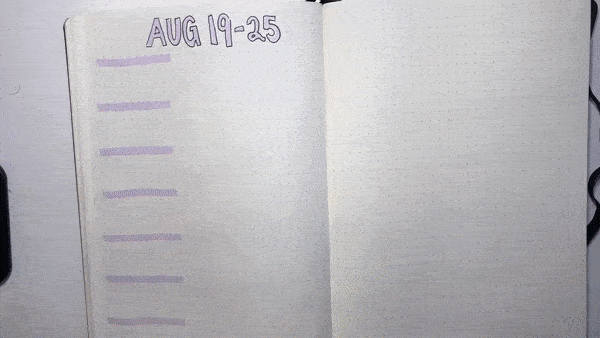I think it’s safe to say that I have a little bit of an interest in task lists and productivity tools.
(This is a safe space, right?)
…ok fine, I’m an addict. I’ve tried no less than 10 task list tools and apps over the years, and I have at least half a dozen written notebooks and planners. (I’m using a bullet journal and ClickUp currently, but more on those another day.) I love getting things done, and I’m always on the hunt for new ways to make my life easier.
But here’s the thing. While the apps all do a fine job of capturing tasks and assigning deadlines, they weren’t necessarily helping me get more done in my life. In fact, I often felt more overwhelmed just looking at the expanding task lists I was dealing with. (Ugh.)
No, the problem isn’t task management. It’s task prioritization.
Where task lists fall short
Let me preface this section by saying that I do use task lists. They’re a great way to capture the mess of things in my brain that I need to get done at work, around the house, and in my biz.
But the major issue I have with task lists is that everything is weighted equally. Dropping off a package at UPS and launching a major campaign at work look identical on a checklist. (By that I mean they’re both a line item with a deadline and my face listed as the responsible party.)
But while one of those tasks is a complex project, the other is a simple errand.
One is time-sensitive, while the other might just have a deadline set so I don’t forget to do it.
That’s the main problem with task lists: no prioritization. If I have 10 tasks listed as “due” today, how do I know which tasks are actually important or urgent compared to tasks that I need to get done at some point?
And furthermore, are my time-sensitive tasks actually helping me achieve my big goals, or are they the result of firefighting, responding to emails, or doing things that other people need from me?
It’s a business, not a busyness
This lack of prioritization is what leads a lot of us into the world of “busyness without getting anything done.” You know what I’m talking about.
We all have nonstop days where we worked every single minute…but when we reflect at the end of the day, what have we actually accomplished?
I think busyness, not goofing off on the internet, is where most hard-working dreamers get stuck.
It’s easy to feel like going through our task list results in a productive day. But realistically, you never finish your whole to-do list, right? Inevitably most of us end up triaging after lunch to decide what can wait and what can’t.
In the meantime, it’s tempting to knock out the easy tasks or the tasks other people ask of us because they either feel urgent or less taxing.
But we need to do the taxing work. The big tough tasks are the only ones that will move your dreams forward.
And that’s why you need a system to focus on your priorities, not just your endless task list.
Research: The Ivy Lee Method
With a clear problem in mind, I set out to find a better way. My current productivity system is based on the Ivy Lee method, which I read about on James Clear’s excellent blog about habit-forming and productivity.
As the story goes, in 1918 Charles M. Schwab hired revered productivity consultant Ivy Lee to help his team accomplish more each day. During his 15 minute meetings with each executive, Lee outlined his daily productivity strategy, which goes something like this:
- At the end of each workday, write down the six tasks you will focus on tomorrow, in order of importance. You can’t write more than six tasks.
- When you arrive at work the next day, start with task number one and work on only task number one until it is complete.
- Move on to task number two and complete until your list is finished. Move unfinished items to the next day.
- Repeat.
AHA, I thought. This is so simple it just might work.
The “Top Three” System
I tried the Ivy Lee Method for a bit, but I found that having six tasks was actually too much for me. I never accomplished everything on my list, and that felt demoralizing. I also had a hard time thinking bigger than one day at a time, so I started to tweak his method to help suit my style.
That’s how the “Top Three” System was born.
This is the daily routine I started using a few years ago both at work and in my own projects, and it’s been the single biggest influence over my productivity ever since. (I know that sounds dramatic, but it’s true!)
Here’s how it works.
- Know your big goals. Although this system is about daily productivity, I would be remiss if I skipped over this major point. In order to be truly effective, you have to know exactly what you’re working toward. We’ll save big-picture goal setting for another time, but for today let’s assume you know what your major projects and goals are.
- Set 3 GOALS for the week. Even if you don’t have your big-picture goals, this is a good place where most people can start. At the beginning of the week (Sunday or Monday), I want you to answer this question. “In order for this week to be successful, what are 3 GOALS I want to accomplish?” For example, one of my goals this week is to publish 3 blog posts.
- Outline a list of 7 days, with 3 task spots each day. Here’s mine:

- Pre-assign a few tasks. Now that you have your three goals, think about what major tasks you’ll need to accomplish in order to hit those goals. (In my example, I needed to brainstorm and write 3 blog posts.) Pre-assign those tasks during different days of the week.
Now here’s the part you’ll actually do each day:
- Set 3 TASKS each day. This is where your task lists and the Ivy Lee method come in. At the end of each day, I want you to look at your goals alongside the brain dump that is your task list. At this point, you’re answering the question, “What are the three most important tasks I need to get done tomorrow?”
You’ll notice I didn’t say “biggest” tasks. There may be times where your most important task won’t take more than 10 minutes, like returning a phone call. But the goal with the Top 3 System is to surface your most important work, regardless of how challenging or time-consuming those tasks will be. - Make it happen! The next day, you’ll focus on those three tasks above everything else. Imagine that your goal is to get those tasks done first, and then if you get through all three, then you can take a look at your task list and try to get through some additional items.
- Repeat. If you don’t get to all three tasks, you may need to move to the next day. But if you regularly hit only 1-2 tasks, you might want to reconsider how large those tasks are and how much you’re realistically able to accomplish in a day.
Why this works
Before we wrap, I want to highlight a few major reasons why this system has been so effective for me.
It keeps things simple
This system is deceptively simple.
(I could’ve summed up this entire post in a sentence. “Write down the three most important tasks you want to accomplish each day and focus on those above everything.”)
But I think the ease of use is why I’ve stuck to it for so long, and why I find it effective. It never takes me more than 2-3 minutes to write my Top 3 at the end of the day, so I never feel friction about doing it, even if I’m busy.
There’s also no tech to work out. I currently use a written notebook for my Top 3 because I like the act of choosing my Top 3 in writing as an end-of-day ritual. But I’ve also used Google Docs, Evernote, the Notes app, and my favorite notes app Bear before, and would recommend anything you like.
The system is what matters, not the tool.
It removes guesswork
Before I started using the Top 3 system, I wasted tons of time between meetings when I had a small window to work, but no real clarity on what to do next. I’d wind up in the land of busyness, where I’d check emails, respond to Slack messages, and review some documents, but I rarely worked on anything meaningful. With this system, I can glance at my Top 3 list throughout the day and know exactly how to best spend my time.
Writing the list at the end of the day is also key. Not only does it help me fully leave work at the end of the day without worrying, but it also helps me get a running start each morning when I arrive because I already know exactly what to do first.
(Well, first I get the coffee. I’m not insane.)
It keeps me focused
The truth? I am terrible at multitasking. Anytime my brain switches from one task to another, even if it’s something small, I can tell there’s a switching cost where I have to readjust to the task at hand.
With the Top 3 system, I can focus on a single task for much longer than usual because I’m confident that I’m working on what’s truly important.
To take the focus one step further, I’ll block off an hour of work time and turn my notifications off when I really want to get in the zone. Blocking off dedicated work time the way I would block off time for a meeting helps me commit to the most important tasks at hand.
Summary
In short, here’s what we’ve learned about task lists and an alternative approach:
- At the end of the day, write down your Top 3 most important tasks for tomorrow. Important doesn’t mean “hard” or “takes a long time.” These are the tasks that will move your goals forward.
- The next day, prioritize the Top 3 over everything else.
- Repeat.



Melissa Guller is the founder of Wit & Wire, where we help everyday experts become profitable course creators. She previously worked full-time for Ramit Sethi, Teachable, and General Assembly. Today, she shares simplified tech tutorials and modern marketing strategies through our blog, YouTube, and Wit & Wire Weekly newsletter
